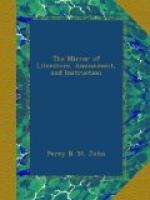ST. DUNSTAN’S, FLEET STREET.
[Illustration]
No church in London is perhaps better known than the above, which is distinctively called Saint Dunstan’s in the West. External elegance has little to do with this celebrity, which has been acquired by the two wooden figures placed on a pediment in front, representing savages, who indicate the hours and quarters by striking a bell with their clubs: this has caused a wag to describe them as the most striking wonders of the metropolis. Another, who is equally disposed to sport with their notoriety, says, “as they are visible in the street, they are more admired by many of the populace on Sundays, than the most elegant preacher from the pulpit within.” We are, however, induced to hope better; especially as Dr. Donne, the celebrated Richard Baxter, and the pious Romaine were preachers at St. Dunstan’s.
There is no evidence when this church was erected; but Stow records burials in it so early as the year 1421. The date of the above view is 1739, and from a foot-note to the Engraving, we learn that the church was dedicated to St. Dunstan, archbishop of Canterbury, who died A.D. 990. “It was anciently a Rectory, in the patronage of the Convent of Westminster. Richard de Barking, the abbot, in 1237, granted the advowson to King Henry III., which continued in the crown till 1362; it was afterwards in the gift of the bishop of London, till 1386; when Robert de Braybrooke, the bishop, granted it to the abbot and Convent of Premonastratenses of Alnwick in Northumberland, where the patronage remained till their suppression. King Edward VI. granted it to the Lord Dudley, but both the Rectory and Advowson of the Vicarage were afterwards granted to Sir Richard Sackville, till alienated to George Rivers, in 1625; it is now in the gift of Joseph Taylor, Esq.” (to whom the Plate is dedicated).
St. Dunstan’s luckily escaped the fire of London in 1666, which stopped within three houses of it, as did also another fire, in 1730. The clock and figures were put up in 1761, and an accurate description of them (quoted from Smith’s London by our esteemed correspondent, P. T. W.) will be found at page 148, vol. xi. of the mirror. The church was thoroughly repaired, and the roof considerably raised in 1701. The last repairs, which were considerable, were executed in the year 1820; but it is expected that the whole building will be shortly taken down, and a new church erected, so as to widen the public thoroughfare.
Our Engraving is an interesting view of the church nearly a century since, when a range of shops (since removed) extended beneath the whole of this side of the structure; and the respective signs must have been unholy appendages to what appeared like part and parcel of a house of prayer. The clock is accurately represented, the bracket being a carved figure of Time with expanded wings, as mention by Smith. The clockmaker proposed to the parish “to do one thing, which London shall not show the like,” and we hope our Engraving may be the means of rescuing his eccentric ingenuity from oblivion.




